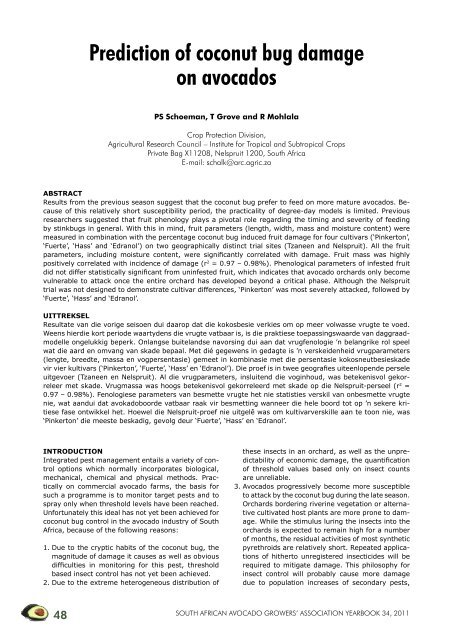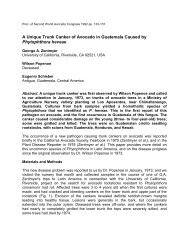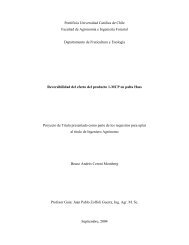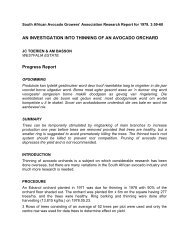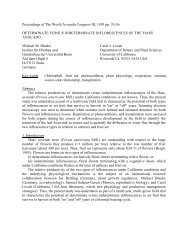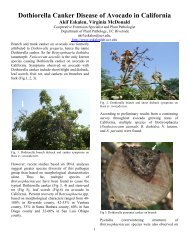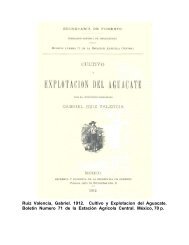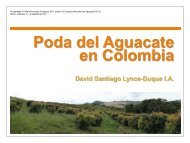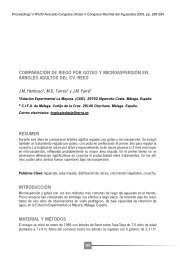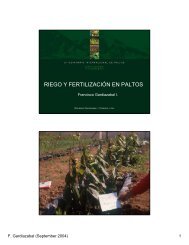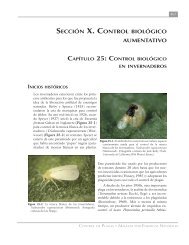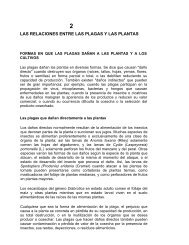Prediction of coconut bug damage on avocados - Avocadosource.com
Prediction of coconut bug damage on avocados - Avocadosource.com
Prediction of coconut bug damage on avocados - Avocadosource.com
Create successful ePaper yourself
Turn your PDF publications into a flip-book with our unique Google optimized e-Paper software.
48<br />
<str<strong>on</strong>g>Predicti<strong>on</strong></str<strong>on</strong>g> <str<strong>on</strong>g>of</str<strong>on</strong>g> <str<strong>on</strong>g>coc<strong>on</strong>ut</str<strong>on</strong>g> <str<strong>on</strong>g>bug</str<strong>on</strong>g> <str<strong>on</strong>g>damage</str<strong>on</strong>g><br />
<strong>on</strong> <strong>avocados</strong><br />
PS Schoeman, T Grove and R Mohlala<br />
crop Protecti<strong>on</strong> divisi<strong>on</strong>,<br />
agricultural research council – institute for tropical and subtropical crops<br />
Private bag X11208, nelspruit 1200, south africa<br />
e-mail: schalk@arc.agric.za<br />
ABSTRACT<br />
Results from the previous seas<strong>on</strong> suggest that the <str<strong>on</strong>g>coc<strong>on</strong>ut</str<strong>on</strong>g> <str<strong>on</strong>g>bug</str<strong>on</strong>g> prefer to feed <strong>on</strong> more mature <strong>avocados</strong>. Because<br />
<str<strong>on</strong>g>of</str<strong>on</strong>g> this relatively short susceptibility period, the practicality <str<strong>on</strong>g>of</str<strong>on</strong>g> degree-day models is limited. Previous<br />
researchers suggested that fruit phenology plays a pivotal role regarding the timing and severity <str<strong>on</strong>g>of</str<strong>on</strong>g> feeding<br />
by stink<str<strong>on</strong>g>bug</str<strong>on</strong>g>s in general. With this in mind, fruit parameters (length, width, mass and moisture c<strong>on</strong>tent) were<br />
measured in <strong>com</strong>binati<strong>on</strong> with the percentage <str<strong>on</strong>g>coc<strong>on</strong>ut</str<strong>on</strong>g> <str<strong>on</strong>g>bug</str<strong>on</strong>g> induced fruit <str<strong>on</strong>g>damage</str<strong>on</strong>g> for four cultivars (‘Pinkert<strong>on</strong>’,<br />
‘Fuerte’, ‘Hass’ and ‘Edranol’) <strong>on</strong> two geographically distinct trial sites (Tzaneen and Nelspruit). All the fruit<br />
parameters, including moisture c<strong>on</strong>tent, were significantly correlated with <str<strong>on</strong>g>damage</str<strong>on</strong>g>. Fruit mass was highly<br />
positively correlated with incidence <str<strong>on</strong>g>of</str<strong>on</strong>g> <str<strong>on</strong>g>damage</str<strong>on</strong>g> (r 2 = 0.97 – 0.98%). Phenological parameters <str<strong>on</strong>g>of</str<strong>on</strong>g> infested fruit<br />
did not differ statistically significant from uninfested fruit, which indicates that avocado orchards <strong>on</strong>ly be<strong>com</strong>e<br />
vulnerable to attack <strong>on</strong>ce the entire orchard has developed bey<strong>on</strong>d a critical phase. Although the Nelspruit<br />
trial was not designed to dem<strong>on</strong>strate cultivar differences, ‘Pinkert<strong>on</strong>’ was most severely attacked, followed by<br />
‘Fuerte’, ‘Hass’ and ‘Edranol’.<br />
UITTREKSEL<br />
Resultate van die vorige seisoen dui daarop dat die kokosbesie verkies om op meer volwasse vrugte te voed.<br />
Weens hierdie kort periode waartydens die vrugte vatbaar is, is die praktiese toepassingswaarde van daggraadmodelle<br />
<strong>on</strong>gelukkig beperk. Onlangse buitelandse navorsing dui aan dat vrugfenologie ’n belangrike rol speel<br />
wat die aard en omvang van skade bepaal. Met dié gegewens in gedagte is ’n verskeidenheid vrugparameters<br />
(lengte, breedte, massa en vogpersentasie) gemeet in kombinasie met die persentasie kokosneutbesieskade<br />
vir vier kultivars (‘Pinkert<strong>on</strong>’, ‘Fuerte’, ‘Hass’ en ‘Edranol’). Die proef is in twee geografies uiteenlopende persele<br />
uitgevoer (Tzaneen en Nelspruit). Al die vrugparameters, insluitend die voginhoud, was betekenisvol gekorreleer<br />
met skade. Vrugmassa was hoogs betekenisvol gekorreleerd met skade op die Nelspruit-perseel (r 2 =<br />
0.97 – 0.98%). Fenologiese parameters van besmette vrugte het nie statisties verskil van <strong>on</strong>besmette vrugte<br />
nie, wat aandui dat avokadoboorde vatbaar raak vir besmetting wanneer die hele boord tot op ’n sekere kritiese<br />
fase <strong>on</strong>twikkel het. Hoewel die Nelspruit-proef nie uitgelê was om kultivarverskille aan te to<strong>on</strong> nie, was<br />
‘Pinkert<strong>on</strong>’ die meeste beskadig, gevolg deur ‘Fuerte’, ‘Hass’ en ‘Edranol’.<br />
INTRODUCTION<br />
Integrated pest management entails a variety <str<strong>on</strong>g>of</str<strong>on</strong>g> c<strong>on</strong>trol<br />
opti<strong>on</strong>s which normally incorporates biological,<br />
mechanical, chemical and physical methods. Practically<br />
<strong>on</strong> <strong>com</strong>mercial avocado farms, the basis for<br />
such a programme is to m<strong>on</strong>itor target pests and to<br />
spray <strong>on</strong>ly when threshold levels have been reached.<br />
Unfortunately this ideal has not yet been achieved for<br />
<str<strong>on</strong>g>coc<strong>on</strong>ut</str<strong>on</strong>g> <str<strong>on</strong>g>bug</str<strong>on</strong>g> c<strong>on</strong>trol in the avocado industry <str<strong>on</strong>g>of</str<strong>on</strong>g> South<br />
Africa, because <str<strong>on</strong>g>of</str<strong>on</strong>g> the following reas<strong>on</strong>s:<br />
1. Due to the cryptic habits <str<strong>on</strong>g>of</str<strong>on</strong>g> the <str<strong>on</strong>g>coc<strong>on</strong>ut</str<strong>on</strong>g> <str<strong>on</strong>g>bug</str<strong>on</strong>g>, the<br />
magnitude <str<strong>on</strong>g>of</str<strong>on</strong>g> <str<strong>on</strong>g>damage</str<strong>on</strong>g> it causes as well as obvious<br />
difficulties in m<strong>on</strong>itoring for this pest, threshold<br />
based insect c<strong>on</strong>trol has not yet been achieved.<br />
2. Due to the extreme heterogeneous distributi<strong>on</strong> <str<strong>on</strong>g>of</str<strong>on</strong>g><br />
these insects in an orchard, as well as the unpredictability<br />
<str<strong>on</strong>g>of</str<strong>on</strong>g> ec<strong>on</strong>omic <str<strong>on</strong>g>damage</str<strong>on</strong>g>, the quantificati<strong>on</strong><br />
<str<strong>on</strong>g>of</str<strong>on</strong>g> threshold values based <strong>on</strong>ly <strong>on</strong> insect counts<br />
are unreliable.<br />
3. Avocados progressively be<strong>com</strong>e more susceptible<br />
to attack by the <str<strong>on</strong>g>coc<strong>on</strong>ut</str<strong>on</strong>g> <str<strong>on</strong>g>bug</str<strong>on</strong>g> during the late seas<strong>on</strong>.<br />
Orchards bordering riverine vegetati<strong>on</strong> or alternative<br />
cultivated host plants are more pr<strong>on</strong>e to <str<strong>on</strong>g>damage</str<strong>on</strong>g>.<br />
While the stimulus luring the insects into the<br />
orchards is expected to remain high for a number<br />
<str<strong>on</strong>g>of</str<strong>on</strong>g> m<strong>on</strong>ths, the residual activities <str<strong>on</strong>g>of</str<strong>on</strong>g> most synthetic<br />
pyrethroids are relatively short. Repeated applicati<strong>on</strong>s<br />
<str<strong>on</strong>g>of</str<strong>on</strong>g> hitherto unregistered insecticides will be<br />
required to mitigate <str<strong>on</strong>g>damage</str<strong>on</strong>g>. This philosophy for<br />
insect c<strong>on</strong>trol will probably cause more <str<strong>on</strong>g>damage</str<strong>on</strong>g><br />
due to populati<strong>on</strong> increases <str<strong>on</strong>g>of</str<strong>on</strong>g> sec<strong>on</strong>dary pests,<br />
south african avocado growers’ associati<strong>on</strong> yearbook 34, 2011
which will then require even more sprays for effective<br />
c<strong>on</strong>trol (pesticide treadmill). Clearly this is<br />
a soluti<strong>on</strong> that will have to be avoided at all cost.<br />
Possible soluti<strong>on</strong>s to this c<strong>on</strong>undrum include:<br />
1. Quantificati<strong>on</strong> <str<strong>on</strong>g>of</str<strong>on</strong>g> phenological parameters to predict<br />
critical periods when fruit be<strong>com</strong>e susceptible<br />
for the <str<strong>on</strong>g>coc<strong>on</strong>ut</str<strong>on</strong>g> <str<strong>on</strong>g>bug</str<strong>on</strong>g>. Mizell et al. (2008) proved<br />
c<strong>on</strong>clusively that fruit phenology and stink<str<strong>on</strong>g>bug</str<strong>on</strong>g> induced<br />
<str<strong>on</strong>g>damage</str<strong>on</strong>g> are interrelated.<br />
2. Evaluate biological alternatives such as the pathogen<br />
Beauveria bassiana. These products are usually<br />
ephemeral but sub lethal doses <str<strong>on</strong>g>of</str<strong>on</strong>g> standard<br />
insecticides <strong>com</strong>bined with the pathogen have<br />
proved to be effective in some cases.<br />
3. Evaluate the effect <str<strong>on</strong>g>of</str<strong>on</strong>g> alternative hosts, not <strong>on</strong>ly<br />
for trap crops but also for m<strong>on</strong>itoring.<br />
4. Study the chemical ecology <str<strong>on</strong>g>of</str<strong>on</strong>g> this stink<str<strong>on</strong>g>bug</str<strong>on</strong>g> with<br />
the l<strong>on</strong>g term aim <str<strong>on</strong>g>of</str<strong>on</strong>g> m<strong>on</strong>itoring and possibly c<strong>on</strong>trol<br />
in mind.<br />
This report must therefore be regarded as a first step<br />
to gain some insight into this <strong>com</strong>plex situati<strong>on</strong>.<br />
MATERIALS AND METHODS<br />
The trial was carried out <strong>on</strong> a <strong>com</strong>mercial farm near<br />
Tzaneen (23° 49’ 18.55”S 30°10’ 31.04”E) and <strong>on</strong><br />
an unsprayed orchard at Nelspruit (25° 26’ 55.73”S<br />
30°58’ 09.77”E). Fruit mass, length and diameter<br />
were determined fortnightly. In Nelspruit the survey<br />
started <strong>on</strong> the 11 th <str<strong>on</strong>g>of</str<strong>on</strong>g> October 2010 and c<strong>on</strong>cluded<br />
<strong>on</strong> the 26 th <str<strong>on</strong>g>of</str<strong>on</strong>g> January 2011. At Tzaneen the survey<br />
started <strong>on</strong> the 12 th <str<strong>on</strong>g>of</str<strong>on</strong>g> October 2010 and c<strong>on</strong>cluded <strong>on</strong><br />
the 4 th <str<strong>on</strong>g>of</str<strong>on</strong>g> February 2011.<br />
Ten fruit were randomly picked from five randomly<br />
selected trees (10 fruit x 5 trees = 50 fruit) at each<br />
trial site. Fruit mass, diameter and length were determined<br />
immediately after picking. Fruit moisture<br />
c<strong>on</strong>tent was also additi<strong>on</strong>ally determined at the Nel-<br />
Table 1. Seas<strong>on</strong>al relati<strong>on</strong>ship between infestati<strong>on</strong> status <str<strong>on</strong>g>of</str<strong>on</strong>g> the <str<strong>on</strong>g>coc<strong>on</strong>ut</str<strong>on</strong>g> <str<strong>on</strong>g>bug</str<strong>on</strong>g> and various fruit parameters for ‘Pinkert<strong>on</strong>’<br />
fruit at the Nelspruit trial site.<br />
Date<br />
29 Nov<br />
14 Dec<br />
11 Jan<br />
26 Jan<br />
Infested<br />
± SD<br />
7.23a ±<br />
0.87<br />
Measured fruit parameter<br />
Length Diameter Mass Moisture c<strong>on</strong>tent<br />
Uninfested<br />
± SD<br />
8.1a ± 1.63<br />
Infested<br />
± SD<br />
3.93a ±<br />
0.22<br />
Uninfested<br />
± SD<br />
4.23a ±<br />
0.41<br />
spruit site, according to the standard re<strong>com</strong>mended<br />
rate <str<strong>on</strong>g>of</str<strong>on</strong>g> Swarts (1976).<br />
Coc<strong>on</strong>ut <str<strong>on</strong>g>bug</str<strong>on</strong>g> <str<strong>on</strong>g>damage</str<strong>on</strong>g> was determined by visually<br />
examining 50 fruit <strong>on</strong> five randomly selected trees<br />
every fortnight (50 fruit x 5 trees = 250 fruit). At<br />
Tzaneen observati<strong>on</strong>s were made <strong>on</strong> ‘Hass’, ‘Pinkert<strong>on</strong>’<br />
and ‘Fuerte’ while <strong>on</strong>ly ‘Pinkert<strong>on</strong>’ and ‘Fuerte’<br />
were studied at the Nelspruit locality.<br />
RESULTS<br />
Although statistical differences were observed between<br />
infestati<strong>on</strong> status and various phenological parameters<br />
(Table 1), n<strong>on</strong>e <str<strong>on</strong>g>of</str<strong>on</strong>g> the relati<strong>on</strong>ships were<br />
c<strong>on</strong>sistent. Uncharacteristic large or small fruit were<br />
not specifically more attractive to this insect, which<br />
indicates that the stimulus required for infestati<strong>on</strong><br />
probably originates from the entire orchard. For this<br />
reas<strong>on</strong>, infestati<strong>on</strong> and c<strong>on</strong><strong>com</strong>itant predicti<strong>on</strong> <str<strong>on</strong>g>of</str<strong>on</strong>g><br />
<str<strong>on</strong>g>coc<strong>on</strong>ut</str<strong>on</strong>g> <str<strong>on</strong>g>bug</str<strong>on</strong>g> feeding <strong>on</strong> smaller amounts <str<strong>on</strong>g>of</str<strong>on</strong>g> out <str<strong>on</strong>g>of</str<strong>on</strong>g><br />
seas<strong>on</strong> fruit will be different. Out <str<strong>on</strong>g>of</str<strong>on</strong>g> seas<strong>on</strong> fruit will<br />
also be the <strong>on</strong>ly source <str<strong>on</strong>g>of</str<strong>on</strong>g> food for stink<str<strong>on</strong>g>bug</str<strong>on</strong>g>s during<br />
the winter, which also explains high <str<strong>on</strong>g>damage</str<strong>on</strong>g> levels <strong>on</strong><br />
small and relatively immature fruit.<br />
According to Figure 1 and 2 significant positive<br />
relati<strong>on</strong>ships were observed between various fruit<br />
phenology parameters and <str<strong>on</strong>g>coc<strong>on</strong>ut</str<strong>on</strong>g> <str<strong>on</strong>g>bug</str<strong>on</strong>g> infestati<strong>on</strong>.<br />
Infestati<strong>on</strong> levels were significantly higher at the Nelspruit<br />
trial site, which probably increased the reliably<br />
<str<strong>on</strong>g>of</str<strong>on</strong>g> the data. The Tzaneen trial site formed part <str<strong>on</strong>g>of</str<strong>on</strong>g> a<br />
<strong>com</strong>mercial farm and the orchard was sprayed <strong>on</strong> a<br />
number <str<strong>on</strong>g>of</str<strong>on</strong>g> occasi<strong>on</strong>s.<br />
Figure 1 and 2 rec<strong>on</strong>firm the observati<strong>on</strong>s <str<strong>on</strong>g>of</str<strong>on</strong>g> Mizell<br />
et al. (2008) which states that phenology plays a pivotal<br />
role in the relative seas<strong>on</strong>al susceptibility <str<strong>on</strong>g>of</str<strong>on</strong>g> fruit<br />
for stink<str<strong>on</strong>g>bug</str<strong>on</strong>g>s in general.<br />
Table 2 portray the magnitude <str<strong>on</strong>g>of</str<strong>on</strong>g> various fruit parameters<br />
when <str<strong>on</strong>g>damage</str<strong>on</strong>g> levels reached the value <str<strong>on</strong>g>of</str<strong>on</strong>g><br />
5%. Edwards and Heath (1964) suggested this as the<br />
general maximum level <str<strong>on</strong>g>of</str<strong>on</strong>g> insect <str<strong>on</strong>g>damage</str<strong>on</strong>g> that can<br />
Infested<br />
± SD<br />
54.8a ±<br />
11.24<br />
Uninfested<br />
± SD<br />
70.01a ±<br />
22.48<br />
Infested<br />
± SD<br />
89.03a ±<br />
4.29<br />
Uninfested<br />
± SD<br />
86.8b ±<br />
0.90<br />
t = 1.05 P = 0.298 t = 1.50 P = 0.138 t = 1.33 P = 0.19 t = 3.08 P = 0.003<br />
10.3a ±<br />
0.86<br />
9.6a ± 1.24<br />
4.87a ±<br />
0.29<br />
4.86a ±<br />
0.48<br />
107.31a<br />
± 17.33<br />
103.24a ±<br />
27.37<br />
86.3a ±<br />
0.52<br />
86.54a ±<br />
0.51<br />
t = 1.44 P = 0.156 t = 0.046 P = 0.963 t = 0.38 P = 0.71 t = 0.64 P = 0.53<br />
11.41a ± 11.38a ± 5.91a ± 5.45b ± 173.45a 155.41a ± 84.56a ± 84.23a ±<br />
1.37 1.47 0.49 0.54 ± 42.36 44.91 1.15 1.36<br />
t = 0.064 P = 0.949 t = 2.25 P = 0.029 t = 1.05 P = 0.29 t = 0.64 P = 0.53<br />
11.22a ± 12.30b ± 5.67a ± 5.90a ± 154.81a 186.84b ± 82.82a ± 83.35a ±<br />
1.43 1.87 0.65 0.64 ± 44.56 56.99 1.83 1.44<br />
t = 2.13 P = 0.038 t = 1.05 P = 0.29 t = 2.087 P = 0.04 t = 1.14 P = 0.26<br />
Means for m<strong>on</strong>itoring dates <str<strong>on</strong>g>of</str<strong>on</strong>g> the various fruit parameters followed by the same letter are not statistically different<br />
south african avocado growers’ associati<strong>on</strong> yearbook 34, 2011 49
50<br />
A B<br />
C<br />
E<br />
G<br />
Figure 1. The relati<strong>on</strong>ship between various phenological<br />
measurements and the percentage infestati<strong>on</strong> by<br />
the <str<strong>on</strong>g>coc<strong>on</strong>ut</str<strong>on</strong>g> <str<strong>on</strong>g>bug</str<strong>on</strong>g> <strong>on</strong> <strong>avocados</strong> (cv. Pinkert<strong>on</strong>). A: Fruit<br />
length (Nelspruit), B: Fruit length (Tzaneen), C: Fruit<br />
diameter (Nelspruit), D: Fruit diameter (Tzaneen), E:<br />
Fruit mass (Nelspruit), F: Fruit mass (Tzaneen), G:<br />
Fruit moisture (Nelspruit).<br />
Table 2. Phenological parameters <str<strong>on</strong>g>of</str<strong>on</strong>g> avocado fruit (cv. Pinkert<strong>on</strong> & Fuerte) when 5% <str<strong>on</strong>g>of</str<strong>on</strong>g> the fruit were<br />
affected by the <str<strong>on</strong>g>coc<strong>on</strong>ut</str<strong>on</strong>g> <str<strong>on</strong>g>bug</str<strong>on</strong>g> (Pseudotheraptus wayi).<br />
Cultivar<br />
‘Pinkert<strong>on</strong>’ ‘Fuerte’<br />
Fruit parameter Nelspruit Tzaneen Nelspruit Tzaneen<br />
Length (mm) 80 170 80 90<br />
Diameter (mm) 40 60 44 63<br />
Mass (g) 70 190 85 115<br />
Moisture (%) 88.6 - 85 -<br />
f<br />
d<br />
south african avocado growers’ associati<strong>on</strong> yearbook 34, 2011
e tolerated before chemical interventi<strong>on</strong> be<strong>com</strong>es<br />
necessary.<br />
Cultivar effects<br />
At Nelspruit ‘Pinkert<strong>on</strong>’ was most severely affected<br />
while it was the least affected cultivar at Tzaneen<br />
A B<br />
C<br />
E f<br />
G<br />
(Figure 3). At first glance this c<strong>on</strong>tradicti<strong>on</strong> appears<br />
rather perplexing, but when the spatial arrangement<br />
<str<strong>on</strong>g>of</str<strong>on</strong>g> the cultivars are c<strong>on</strong>sidered relative to each other<br />
and to the natural bush, things became a bit clearer.<br />
In Nelspruit all four cultivars are planted next to a<br />
mango orchard which acted as the primary source <str<strong>on</strong>g>of</str<strong>on</strong>g><br />
Figure 2. The relati<strong>on</strong>ship between various phenological<br />
measurements and the percentage infestati<strong>on</strong><br />
by the <str<strong>on</strong>g>coc<strong>on</strong>ut</str<strong>on</strong>g> <str<strong>on</strong>g>bug</str<strong>on</strong>g> <strong>on</strong> <strong>avocados</strong> (cv. Fuerte). A: Fruit<br />
length (Nelspruit), B: Fruit length (Tzaneen), C: Fruit<br />
diameter (Nelspruit), D: Fruit diameter (Tzaneen), E:<br />
Fruit mass (Nelspruit), F: Fruit mass (Tzaneen), G:<br />
Fruit moisture (Nelspruit).<br />
south african avocado growers’ associati<strong>on</strong> yearbook 34, 2011 51<br />
d
infestati<strong>on</strong>. The stink<str<strong>on</strong>g>bug</str<strong>on</strong>g>s <strong>on</strong>ly had to fly a few metres<br />
and probably selected the most suitable cultivar.<br />
At Tzaneen ‘Pinkert<strong>on</strong>’ trees were planted close to<br />
the centre <str<strong>on</strong>g>of</str<strong>on</strong>g> the orchard with ‘Fuerte’ trees <strong>on</strong> the<br />
perimeter. Stink<str<strong>on</strong>g>bug</str<strong>on</strong>g>s migrated into the orchard from<br />
the surrounding natural bush and landed <strong>on</strong> the first<br />
avocado trees. Because their need for food, shelter<br />
and mate locati<strong>on</strong> was satisfied, further migrati<strong>on</strong><br />
deeper into the orchard was limited. This observati<strong>on</strong><br />
is corroborated by Todd (1989) who ascribed<br />
the extreme heterogeneous distributi<strong>on</strong> <str<strong>on</strong>g>of</str<strong>on</strong>g> stink<str<strong>on</strong>g>bug</str<strong>on</strong>g>s<br />
to limited movement in an orchard <strong>on</strong>ce all primary<br />
needs (food, shelter and mate locati<strong>on</strong>) have been<br />
satisfied.<br />
CONCLUSION<br />
1. Fruit phenology (maturity) is directly related to the<br />
severity <str<strong>on</strong>g>of</str<strong>on</strong>g> <str<strong>on</strong>g>damage</str<strong>on</strong>g> caused by the <str<strong>on</strong>g>coc<strong>on</strong>ut</str<strong>on</strong>g> <str<strong>on</strong>g>bug</str<strong>on</strong>g>.<br />
This observati<strong>on</strong> supports the earlier findings <str<strong>on</strong>g>of</str<strong>on</strong>g><br />
Mizell et al. (2008) in this regard.<br />
2. Towards the end <str<strong>on</strong>g>of</str<strong>on</strong>g> the seas<strong>on</strong> there were such<br />
large numbers <str<strong>on</strong>g>of</str<strong>on</strong>g> stink<str<strong>on</strong>g>bug</str<strong>on</strong>g>s in the orchards that<br />
small out <str<strong>on</strong>g>of</str<strong>on</strong>g> seas<strong>on</strong> fruit were also invariably affected.<br />
Additi<strong>on</strong>ally, when the food source (avocado<br />
fruit) was removed at harvest, the stink<str<strong>on</strong>g>bug</str<strong>on</strong>g>s<br />
probably did not have an opti<strong>on</strong> but to feed <strong>on</strong> the<br />
small immature fruit. This theory is supported by<br />
an observati<strong>on</strong> <strong>on</strong> the research farm <str<strong>on</strong>g>of</str<strong>on</strong>g> the ARC-<br />
ITSC where large numbers <str<strong>on</strong>g>of</str<strong>on</strong>g> <str<strong>on</strong>g>coc<strong>on</strong>ut</str<strong>on</strong>g> <str<strong>on</strong>g>bug</str<strong>on</strong>g>s c<strong>on</strong>verged<br />
<strong>on</strong> out <str<strong>on</strong>g>of</str<strong>on</strong>g> seas<strong>on</strong> mango fruit towards the<br />
end <str<strong>on</strong>g>of</str<strong>on</strong>g> the 2010/11 seas<strong>on</strong>.<br />
Figure 3. Cultivar preference <str<strong>on</strong>g>of</str<strong>on</strong>g> the <str<strong>on</strong>g>coc<strong>on</strong>ut</str<strong>on</strong>g> <str<strong>on</strong>g>bug</str<strong>on</strong>g>. A: unsprayed locality (Nelspruit), B: <strong>com</strong>mercially managed orchard<br />
(Tzaneen).<br />
52<br />
A B<br />
3. Differing levels <str<strong>on</strong>g>of</str<strong>on</strong>g> management influences fruit<br />
size and fruit mass too much for a reliable re<strong>com</strong>mendati<strong>on</strong>.<br />
It is suggested that moisture c<strong>on</strong>tent<br />
versus infestati<strong>on</strong> levels be <strong>com</strong>pared <strong>on</strong> a number<br />
<str<strong>on</strong>g>of</str<strong>on</strong>g> farms to determine if accurate predicti<strong>on</strong>s <str<strong>on</strong>g>of</str<strong>on</strong>g><br />
<str<strong>on</strong>g>coc<strong>on</strong>ut</str<strong>on</strong>g> incursi<strong>on</strong>s into avocado orchards can be<br />
made.<br />
4. Because <str<strong>on</strong>g>damage</str<strong>on</strong>g> escalated significantly towards<br />
the end <str<strong>on</strong>g>of</str<strong>on</strong>g> the producti<strong>on</strong> seas<strong>on</strong>, n<strong>on</strong>-chemical<br />
c<strong>on</strong>trol methods such as Beauveria bassiana<br />
should be investigated mainly due to the favourable<br />
residue pr<str<strong>on</strong>g>of</str<strong>on</strong>g>ile <str<strong>on</strong>g>of</str<strong>on</strong>g> biological alternatives.<br />
5. Cultivar preferences are difficult to quantify, as the<br />
c<strong>on</strong>figurati<strong>on</strong> <str<strong>on</strong>g>of</str<strong>on</strong>g> bordering host plants play a large<br />
role in determining the eventual fate <str<strong>on</strong>g>of</str<strong>on</strong>g> fruit, especially<br />
towards the end <str<strong>on</strong>g>of</str<strong>on</strong>g> the seas<strong>on</strong>. It would,<br />
however, appear as if the cultivar ‘Pinkert<strong>on</strong>’ is<br />
predisposed to more severe <str<strong>on</strong>g>damage</str<strong>on</strong>g>.<br />
LITERATURE CITED<br />
EDWARDS, C.A. & HEATH, G.W. 1964. Principles in Agricultural<br />
Entomology. Ed. Chapman and Hall, L<strong>on</strong>d<strong>on</strong>, 418pp.<br />
MIZELL, R.F., RIDDLE, T.C. & BLOUNT, A.S. 2008. Trap<br />
cropping system to suppress stink <str<strong>on</strong>g>bug</str<strong>on</strong>g>s in the Southern<br />
Coastal plain. Proceedings <str<strong>on</strong>g>of</str<strong>on</strong>g> the Florida State Horticultural<br />
Society, pp 1 – 16.<br />
SWARTS, D.H. 1976. ’n Praktiese avokado-oliebepalingsmetode<br />
vir produsente. The Citrus and Subtropical Fruit<br />
Journal, 5(11): 8-14.<br />
TODD, J.W. 1989. Ecology and behaviour <str<strong>on</strong>g>of</str<strong>on</strong>g> Nezara viridula.<br />
Annual Review <str<strong>on</strong>g>of</str<strong>on</strong>g> Entomology, 34: 273-92.<br />
south african avocado growers’ associati<strong>on</strong> yearbook 34, 2011


